Muscular balance, better movement control and improved flexibility are all within reach when you take a smart approach to stretching. So what do the experts recommend? And which moves do the professionals favour? We take a look at how to perfect your stretch routine...
What are the best types of stretches for your body?
Choosing the best way to stretch comes down to the purpose of the stretch. If your aim is to mobilise before exercise or sport, then dynamic stretches (like backward stepping lunges with a trunk twist or arm swings) are often best. These types of stretches are best-suited to preparing the muscles for the dynamic nature of what lies ahead. If your aim is to address postural imbalances, then long, static stretching is more appropriate.
Which are the best muscles to stretch?
If you're adding a stretch routine into your week, or stretching after class to assist recovery, a general approach is fine. However, if you’re stretching an area due to ongoing pain or tension, it starts to become a little tricky to identify the best target. Working out what muscles to stretch is not always clear cut.
For example, if your shoulders are rounded, it can create discomfort across the upper back. A lot of people try to alleviate this tension by stretching, perhaps clasping the hands in front of the body and pushing the arms forward while rounding the upper back. Intuitively this feels like it’s doing something to address the discomfort, but it’s just stretching tissues that are already lengthened. Often when we assess these people, we find a shortened muscle in the opposing muscle group (in these cases often within the pecs). Stretching these short muscles which are usually not associated with the discomfort is often more effective.
Is it best to stretch pre- or post-workout?
Stretching after a workout is beneficial because the muscles are warm, which can allow you to push a little deeper into the stretch. A post-workout stretch is also a good opportunity to cool down and bring your tissues back to resting level.
A dedicated stretch session is a great way to really focus on postural release and joint awareness. Consider the static position of sitting using a keyboard which many of us do for hours on end. A dedicated mobility session helps to restore balance to the muscles by taking the body out of those sustained postures.
The other benefit of this is increased proprioception (the awareness of your body's position and movements). Our joints and muscles are full of sensors that inform the brain on how we move and the position of our limbs in space. Mobility workouts help to spark up these receptors, which often lie dormant as a result of static postures. The increased sensitivity results in better balance and movement control.
Is becoming more flexible and bendy the main reason to stretch?
I believe the main benefit of stretching is improving movement control and muscle balance. Flexibility is part of this, as is muscle strength and proprioception. For most of us, supreme flexibility is not necessary. In fact, sometimes people who are very flexible or hypermobile have just as many (if not more) injuries than those who lack flexibility.
How can stretching improve your athletic performance?
Resistance training is key to improving athletic performance – and safe and effective resistance training requires movement precision to ensure the load is isolated to the target muscles. If there are imbalances from excessive muscle shortening or training some muscle groups more than others, it can disrupt movement control. A regular muscle balance routine, including stretches targeting the shortened groups, can greatly improve the effectiveness and sustainability of a resistance training program.
Some researchers have found that stretching opposing muscle groups during rest periods when lifting weights can result in more output of the targeted group. For example, stretching the pecs between sets of seated rows increased the number of reps able to be performed in each set.
Intuitively, we might assume that stretching is effective for reducing injury incidence. However, this has proven difficult to demonstrate. One study looked at 1000 army recruits performing basic training. Some were given a conditioning program including stretches, while others acted as a control. After 12 weeks there was no difference in lower limb injury incidence between the two groups. Injury prevention is a complex area, while stretching plays a role in improving muscle function, translating that to less injuries has proven difficult to demonstrate in a research setting. But there is plenty of anecdotal evidence that it helps.


